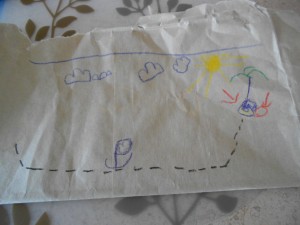Just as children have their own strengths and challenges, they also have their own ways to play. Pirate play activities are favorites of another boy. His name also starts with R and he is 4 and a half years old. His mother describes his play:
R likes playing pirates with daddy. His daddy will hide a little baggie filled with “treasure.” They build a boat with couch cushions and shoot cannon balls to scare awake the sharks. Then follow a map to find the treasure. I’m usually upstairs when they do this and all I hear is outbursts of “Yo ho ho!” and “Shiver me timbers!”
Doesn’t this sound wonderful? I’m sure both R and his daddy have lots of fun. Pretend play can start with quite young toddlers, and it gets much more involved as kids get older. Likely, R and his parents have read pirate books, maybe watched some pirate shows, and talked about pirates. In a way, he has made a collection of information that he has stored up about pirates, like treasure in a chest. He uses what he knows as he pretends pirates.
Pretend play builds more than imagination. It also builds empathy. For children to understand what another person is feeling, they need to be able to imagine themselves in that situation. Don’t we often say to kids, “How would you feel if…?” Children can only do this, if they have some skills to pretend. When we are trying to teach kids about safety, we also ask them to use their imagination. When we ask, “What could happen if…” we are also asking kids to imagine.
Pretend play is powerful for brains as children connect their thinking to actions. Creating a mental picture of the whole story is the critical skill of visualizing. There’s lots of organizing and planning too, as well as special ways to use language. These pirate play activities are a treasure for learning and fun, aren’t they? Any kid-pirates at your house?

